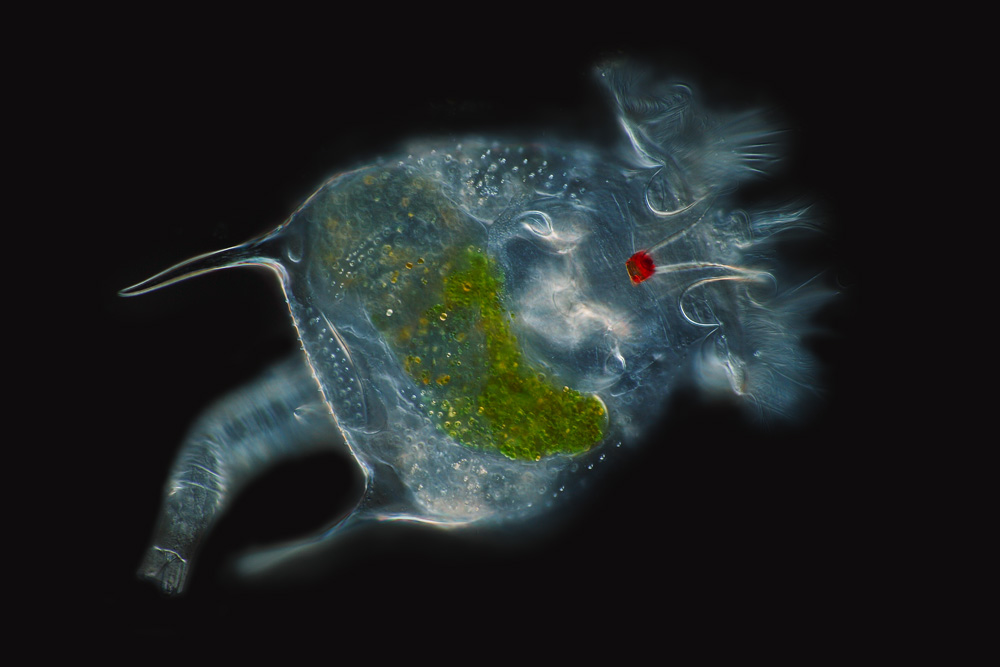Brachionus on:
[Wikipedia]
[Google]
[Amazon]
 ''Brachionus'' is a
''Brachionus'' is a
 ''Brachionus'' is a
''Brachionus'' is a genus
Genus ( plural genera ) is a taxonomic rank used in the biological classification of living and fossil organisms as well as viruses. In the hierarchy of biological classification, genus comes above species and below family. In binomial nom ...
of plankton
Plankton are the diverse collection of organisms found in water (or air) that are unable to propel themselves against a current (or wind). The individual organisms constituting plankton are called plankters. In the ocean, they provide a cruc ...
ic rotifer
The rotifers (, from the Latin , "wheel", and , "bearing"), commonly called wheel animals or wheel animalcules, make up a phylum (Rotifera ) of microscopic and near-microscopic pseudocoelomate animals.
They were first described by Rev. John H ...
s occurring in freshwater
Fresh water or freshwater is any naturally occurring liquid or frozen water containing low concentrations of dissolved salts and other total dissolved solids. Although the term specifically excludes seawater and brackish water, it does incl ...
, alkaline
In chemistry, an alkali (; from ar, القلوي, al-qaly, lit=ashes of the saltwort) is a basic, ionic salt of an alkali metal or an alkaline earth metal. An alkali can also be defined as a base that dissolves in water. A solution of a ...
and brackish water
Brackish water, sometimes termed brack water, is water occurring in a natural environment that has more salinity than freshwater, but not as much as seawater. It may result from mixing seawater (salt water) and fresh water together, as in estuari ...
.
Species
Species included in ''Brachionus'' include: * '' Brachionus amsterdamensis'' De Smet, 2001 * '' Brachionus angularis'' Gosse, 1851 * '' Brachionus asplanchnoides'' Charin, 1947 * '' Brachionus calyciflorus'' Pallas, 1766 * ''Brachionus diversicornis
''Brachionus'' is a genus of planktonic rotifers occurring in freshwater, alkaline and brackish water.
Species
Species included in ''Brachionus'' include:
* ''Brachionus amsterdamensis'' De Smet, 2001
* ''Brachionus angularis'' Gosse, 1851
...
'' (Daday, 1883)
* '' Brachionus havanaensis'' Rousselet, 1911
* '' Brachionus ibericus'' Ciros-Peréz, Gómez & Serra, 2001
* '' Brachionus leydigii'' Cohn, 1862
* '' Brachionus manjavacas'' Fontaneto, Giordani, Melone & Serra, 2007
* '' Brachionus nilsoni'' Ahlstrom
* ''Brachionus plicatilis
''Brachionus plicatilis'' is a euryhaline (tolerate a wide range of salinity) rotifer in the family '' Brachionidae'', and is possibly the only commercially important rotifer, being raised in the aquaculture industry as food for fish larvae. It ha ...
'' Müller, 1786
* '' Brachionus quadridentatus'' Hermann, 1783
* '' Brachionus rotundiformis'' Tschugunoff, 1921
* '' Brachionus rubens'' Ehrenberg, 1838
* '' Brachionus urceolaris'' Müller, 1773
* '' Brachionus variabilis'' Hempel, 1896
Use
Rotifers such as ''Brachionus calyciflorus'' are favored test animals in aquatic toxicology because of their sensitivity to most toxicants. They also are used as model organisms in various other biological fields e.g. due to their interesting reproductive mode in evolutionary ecology. Brachionus spp. are easily reared in large numbers and because of this are used to substitute for wild zooplankton for feeding hatchery reared larval fish. However, the composition of rotifers generally does not satisfy the nutritional requirements of fish larvae, and large amounts of research have been invested in improving the lipid, vitamin and mineral composition of rotifers to better meet the requirements of fish larvaeReproduction
Brachionus species can normally reproduce sexually and asexually (cyclicalparthenogenesis
Parthenogenesis (; from the Greek grc, παρθένος, translit=parthénos, lit=virgin, label=none + grc, γένεσις, translit=génesis, lit=creation, label=none) is a natural form of asexual reproduction in which growth and developmen ...
). Sexual reproduction (termed Mixis) is usually induced when population density increases. Mixis in ''Brachionus plicatilis
''Brachionus plicatilis'' is a euryhaline (tolerate a wide range of salinity) rotifer in the family '' Brachionidae'', and is possibly the only commercially important rotifer, being raised in the aquaculture industry as food for fish larvae. It ha ...
'' has been shown to be induced by a density-dependent chemical cue.
Transitions to obligate parthenogenesis have been described in '' Brachionus calyciflorus''. In this species, obligate parthenogenesis can be inherited by a recessive allele, which leads to loss of sexual reproduction in homozygous offspring. In ''Brachionus manjavacas'' rotifers, offspring's survival and its cell's ability to growth and division decrease with advancing age of mother.
Genome size
Haploid '1C' genome sizes in Brachionus species range at least from 0.056 to 0.416 pg.Genome sequencing
The complete mitochondrial genome of ''B. plicatilis'' sensu stricto NH1L has been sequenced.Cryptic species
''Brachionus plicatilis
''Brachionus plicatilis'' is a euryhaline (tolerate a wide range of salinity) rotifer in the family '' Brachionidae'', and is possibly the only commercially important rotifer, being raised in the aquaculture industry as food for fish larvae. It ha ...
'' has been demonstrated to be a large cryptic species complex
In biology, a species complex is a group of closely related organisms that are so similar in appearance and other features that the boundaries between them are often unclear. The taxa in the complex may be able to hybridize readily with each ot ...
consisting of several different species. It has a worldwide diversity of at least 14 - 22 cryptic taxa.
'' Brachionus calyciflorus'' also seems to be a cryptic species complex.Brachionus calyciflorus is a species complex: mating behavior and genetic differentiation among four geographically isolated strains JJ Gilbert, EJ Walsh - Rotifera X, 2005 - Springer
References
Huang, L. "Effectof Aldrin on Life History Characteristics of Rotifer Brachionus calyciflorus Pallas." Bull Environ Contam Toxicol no5 N 2007 {{Taxonbar, from=Q3516967 Rotifer genera Brachionidae